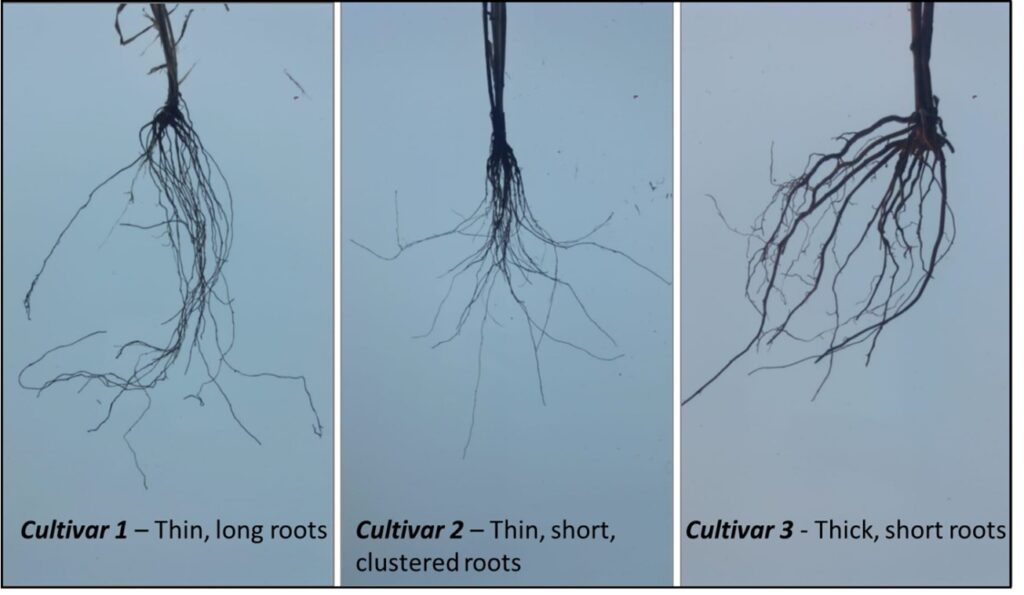Links between root architecture, root exudates and soil microbes
Humanity is presently facing several threats including food insecurity that are exacerbated by climate change and the dwindling arable land reserves.
There is a dire need to increase food production to ensure that the projected 10 billion people populating the Earth by 2050 are sufficiently fed. To achieve this, crops of the future need to flourish even with limited land, water and nutrient supply.
To address these challenges, crop breeding strategies have long been implemented to improve above-ground biomass to enhance crop yield. In spite of the leaps and bounds made by breeding programmes to increase yields, the high-yielding cultivars often struggle with modern day stresses related to climate change. This is probably the result of breeding programmes focusing on above-ground traits and neglecting below-ground traits related to crop roots and their associated impact on soil microorganisms and functions.

Plant roots form the primary interface between the soil and the plant. Roots explore the soil and play a key role in water and nutrient acquisition by the plant. Architectural traits of roots include the surface area of the root, root length and thickness, the degree of root branching and root depth, among others. The architecture/structure of the roots determines the degree of contact they have with the soil. Root architecture is determined by the genetics of the plant as well as environmental factors such as soil type, composition of the soil, moisture content and nutrient availability. Research studies have shown that there is a positive relationship between root architecture and crop yield. However, the interface between soil and roots is very complex and the root architecture itself is not the only factor that influences plant growth. The rhizosphere, which is the region of the soil that directly interacts with plant roots, is influenced by secretions from the roots (exudates). These root exudates control the rhizosphere soil microbes and their functions, which contributes to improved plant growth.
Root architectural traits
Root exudates and microbe recruitment
Plants fix atmospheric carbon through photosynthesis and produce sugars and other essential carbon compounds to grow. However, at some stages of the plant’s development, 30-40% of the carbon is sent to the roots in the form of exudates. This begs the question, why do plants expend energy on the production and secretion of root exudates instead of directing all their energy towards plant growth?
Exudates from roots include amino acids, sugars, organic acids and hormones, as well as highly specialized compounds to control the soil microorganisms. These exudates serve several beneficial roles in the soil and to the plant. They may have a toxic effect on plant pathogens and may even have allelopathic properties, thereby preventing out-competition by neighbouring weeds and plants. Exudates may also aid in plant establishment and resilience in the soil.
Another important function of the exudates is the recruitment of soil microbes to the rhizosphere. These microbes utilize the exudates as a carbon and nutrient source and in turn provide the plant with plant nutrients like phosphorus and water. An example is mychorrhizal fungi. Studies have shown that the exudate profile of plants enables the recruitment of selected microbial taxa. This adds to the amazing properties of plants. Being a brainless, sessile organism, the plant is still able to shape the microbial population in its rhizosphere to ensure that it benefits substantially from the relationship. So, why are we not seeking strategies to put this intricate relationship in the rhizosphere to more use, to maximize food production?
Whilst several studies have been conducted on the introduction of microbial inoculants with plant growth promoting properties into agroecosystems, fewer studies have focused on the engineering of pre-existing, indigenous microbiomes. Microbiome engineering in the rhizosphere may be achieved by breeding plants with specific, desirable root architectural and functional traits such as the release of specialized compounds with the root exudates.
Breeding for below-ground traits
The morphology and architecture of plant roots coupled with soil type are of utmost importance for water and nutrient acquisition, hence certain root architectural traits have been a breeding target to enhance climate resilience in crops. One aspect that is missing, however, is the breeding of plants with root traits that promote a more robust, plant-beneficial rhizospheric microbiome. This breeding strategy would improve the interaction between the soil, plant roots and rhizospheric microbes, which is essential for the development and health of plants.
For example, root diameter may be considered as a targeted trait. In this instance, thinner roots may be considered for their positive attributes, which influence rhizospheric microbiome dynamics. Thin roots secrete higher levels of root exudates than thicker roots, allowing a more effective recruitment of beneficial rhizospheric microbes. Thinner roots also promote nutrient cycling due to increased root turnover.
Moreover, space constraints on thinner roots promote competition between rhizobacteria. With further study of the influence of root architecture on microbiome dynamics, several additional root architectural traits may be targeted with the aim of engineering a robust, resilient rhizospheric microbiome that could contribute to improving the fitness of crops when exposed to stresses related to variable or extreme weather conditions.
WISH-ROOTS project and partners
An ongoing project titled “Tuning the wheat root microbiome to improve soil health and optimize rhizosphere nitrogen cycling and availability (WISH-ROOTS)” aims at restoring and preserving soil health through wheat root traits by screening root traits for 20 landrace cultivars of bread and durum wheat. The international research consortium include partners from the United Kingdom, Italy, South Africa, China, Germany, Belgium and Spain. Overall, the project anticipates to provide resources to develop advantageous cultivars for farmers that support a more sustainable use of land, by reintroducing the positive traits of the landraces, such as beneficial root architectural traits, thereby improving soil microbial biodiversity and structure, as well as nutrient cycling.
The WISH-ROOTS project is funded by the European Joint Programme Soil ERA-NET (HORIZON 2020) and the New Zealand Government to support the objectives of the Global Research Alliance on Agricultural Greenhouse Gases (GRA). The Agricultural Research Council (ARC) is leading the South African component of the project.
For more information:
Visit the WISH-ROOTS website: https://www.wishroots-ejpsoil.net/
and social media page: https://twitter.com/wish_roots
or contact:
Dr Ashira Roopnarain; e-mail:
RoopnarainA@arc.agric.za
Dr Busiswa Ndaba; e-mail:
NdabaB@unisa.ac.za
Mr Michael Kidson; e-mail:
Michael@arc.agric.za
Dr Buhlebelive Mndzebele; e-mail: MndzebeleB@arc.agric.za
Dr Maria Hernandez-Soriano; e-mail:
Maria.Hernandez-Soriano@jic.ac.uk
ARC-Natural Resources and Engineering (NRE) & Vegetable, Industrial and Medicinal Plants (VIMP); University of South Africa (UNISA) and John Innes Centre, UK




